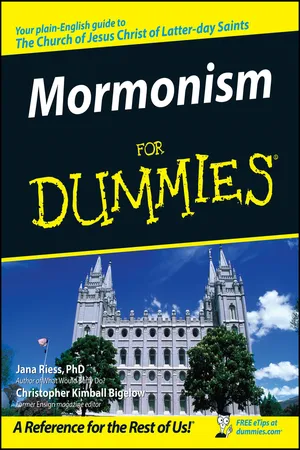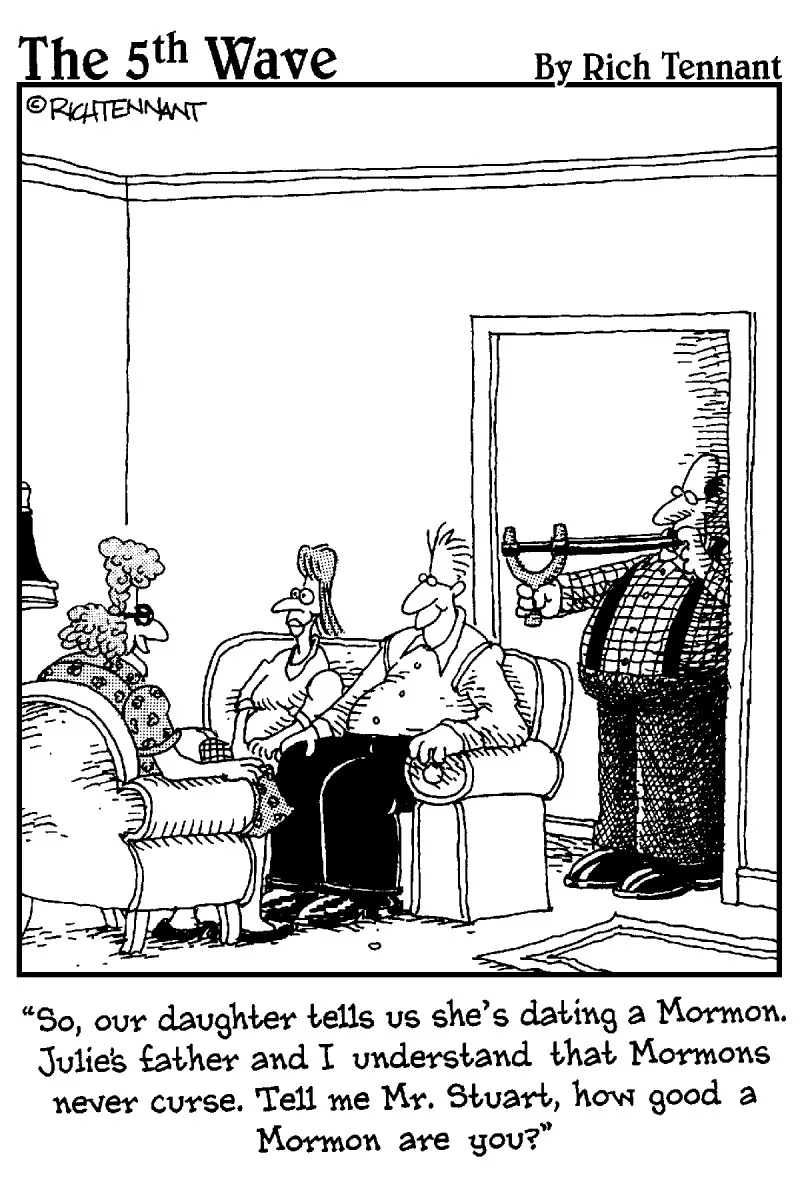
This is a test
- English
- ePUB (mobile friendly)
- Available on iOS & Android
eBook - ePub
Mormonism For Dummies
Book details
Book preview
Table of contents
Citations
About This Book
Get the facts on temples, tithing, missions, and caffeine Mormon doctrines, rituals, and history, demystified at last! Mormonism, or the LDS Church, is one of the world's fastest growing religions. But unless you were raised a Mormon, you probably don't have a clear picture of LDS beliefs and practices. Covering everything from Joseph Smith and the Book of Mormon to tithing and family home evening, this friendly guide will get you up to speed in no time. Discover:
* How the LDS Church differs from other Christian churches
* What Mormons believe
* What happens in Mormon temples and meetinghouses
* The history of the LDS Church
* LDS debates on race, women, and polygamy
Frequently asked questions
At the moment all of our mobile-responsive ePub books are available to download via the app. Most of our PDFs are also available to download and we're working on making the final remaining ones downloadable now. Learn more here.
Both plans give you full access to the library and all of Perlego’s features. The only differences are the price and subscription period: With the annual plan you’ll save around 30% compared to 12 months on the monthly plan.
We are an online textbook subscription service, where you can get access to an entire online library for less than the price of a single book per month. With over 1 million books across 1000+ topics, we’ve got you covered! Learn more here.
Look out for the read-aloud symbol on your next book to see if you can listen to it. The read-aloud tool reads text aloud for you, highlighting the text as it is being read. You can pause it, speed it up and slow it down. Learn more here.
Yes, you can access Mormonism For Dummies by Jana Riess, Christopher Kimball Bigelow in PDF and/or ePUB format, as well as other popular books in Theology & Religion & Christian Denominations. We have over one million books available in our catalogue for you to explore.
Information
Part I
What the Mormon Faith Is All About

In this part . . .
H ere you find out the basics about what Mormons believe, including important stuff about God, Jesus Christ, the premortal life, the plan of salvation, and the afterlife. You also discover what happened in the 19th century when Joseph Smith was called as a prophet to restore the church of Jesus Christ and how the Mormon priesthood is organized and used today. Finally, you get to know more about the family: Why is the family such an important concept in Mormonism? Why do Mormons tend to have larger-than-usual families? Why are they so into genealogy?
Chapter 1
A New World Religion
In This Chapter





Buddhism, Judaism, Islam, Hinduism, traditional branches of Christianity — and Mormonism? If you ask some demographers and sociologists, the idea of Mormonism emerging as the newest major world religion isn’t far fetched. In the Christian sector, although Protestantism grew out of Catholicism, Mormonism bills itself as a completely fresh start, with enough distinctive beliefs and practices to back up that claim.
Mormonism isn’t the newest kid on the religious block, but its start during the 1820s seems relatively recent — in fact, compared to other world religions, Mormonism is a toddler, still maturing in terms of culture, identity, growth, government, and other aspects. As a blueprint for the rest of the book, this opening chapter gives an overview of what it means to be a Mormon.
Why Know about Mormonism?
If you ask Mormon missionaries why you should find out more about Mormonism, they’ll tell you that the LDS Church is the restoration of the Savior’s true church, and he wants you to convert. However, we suspect this answer won’t satisfy many of our non-Mormon readers, so here are some other reasons:


• At the end of 2003, the Church had 5.5 million members in the U.S. and nearly 12 million members worldwide, almost triple its total in 1978. For several decades, the Church has added about 300,000 new converts every year. (For more on missionary work and Church growth around the world, see Chapter 14.)
• The National Council of Churches reported in 2004 that the LDS Church was the fifth-largest U.S. religious body, after the Roman Catholic Church, Southern Baptist Convention, United Methodist Church, and Church of God in Christ. The LDS Church is now larger than any of the mainline Protestant denominations, such as Lutheran, Presbyterian, or Episcopalian, in the U.S.
• The Yearbook of American and Canadian Churches, 2004 (Abingdon Press) reports that the LDS Church had the highest rate of growth (1.88 percent per year in the United States) among the 15 largest U.S. Churches. The growth rate abroad is even higher.

• Strengthening families: Mormons are known for their large, tight-knit, superfunctional families. One main reason is that Mormons believe families can be together forever (for more on this idea, see Chapter 5). Also, the LDS Church teaches practical techniques for strengthening families, such as family home evening (for more info, see Chapter 17).
• Providing for the needy: Marshalling its organizational might, the LDS Church has created one of the world’s most admired systems for helping people provide for their own material needs. Church-owned farms, ranches, canneries, storehouses, and other enterprises provide not only essential goods but also employment. Increasingly, the Church shares its bounty with people outside the faith. (For more on the Church’s welfare program and humanitarian efforts, see Chapter 8.)
• Maintaining health: When founding prophet Joseph Smith introduced Mormonism’s health code, known as the Word of Wisdom, little did he know that science would validate many of these teachings more than 100 years later. Likewise, the Mormon law of chastity helps reduce a host of physical, emotional, and spiritual ills. Today, Mormons are known for enjoying some of the most favorable health rates of any demographic group. (For more on these teachings, see Chapter 16.)
The Mormon Worldview

One main key to getting the gist of Mormonism is the belief that a person’s existence doesn’t begin with birth on this earth. Rather, Mormons believe that all people lived as spirits before coming here. For Mormons, this belief helps explain a whole lot about the conditions and purposes of this earthly life, which they view as God’s test of his children. In addition, Mormons hold some unusual views about the afterlife, particularly regarding what human beings can become. (For a more detailed treatment of these beliefs, see Chapter 2.)
Life before mortal life
If life doesn’t start with conception and birth, when does it start? For Mormons, it never really started, because each person has an eternal essence that has always existed. However, Mormons believe that God created spiritual bodies to house each person’s eternal essence, so he’s the spiritual father of humankind. All human spirits were born before the earth was created.
Sitting at the knee of God and his wife, many spirit children expressed a desire to grow up and become like their Heavenly Parents (for more on them, see Chapter 3). So God set up the plan of salvation, which involved creating an earth where his children could gain physical bodies and go through a challenging test of faith and obedience. Those who pass the test with flying colors get the chance to eventually start an eternal family like God’s.
In premortality, as Mormons call this stage, two of the oldest spirit siblings made a big impression. The first spirit, named Jehovah, volunteered to help everyone overcome the sin and death they’d unavoidably encounter during the earthly test, and this brother was eventually born on earth as Jesus Christ (for more about him, see Chapter 3). Mormons believe he’s their Savior and strive to be like him. The other spirit, named Lucifer, rebelled against God’...
Table of contents
- Title
- Contents
- Introduction
- Part I : What the Mormon Faith Is All About
- Chapter 1: A New World Religion
- Chapter 2: The Mormon Plan of Salvation
- Chapter 3: Heavenly Parents, Savior, and Holy Ghost
- Chapter 4: Restoring the Priesthood and the Church
- Chapter 5: Together Forever: The Eternal Importance of Family
- Part II : Eternal Rituals and Endless Meetings
- Chapter 6: Welcome to the Meetinghouse!
- Chapter 7: Sacred, Not Secret: Inside Mormon Temples
- Chapter 8: In and around Church Headquarters
- Part III : Holy Books and Sacred History
- Chapter 9: The Bible and the Book of Mormon
- Chapter 10: Mormonism’s Other Scriptures
- Chapter 11: Searching for a Home
- Chapter 12: Moving on to Utah with Brigham Young
- Chapter 13: Building the Kingdom in Utah
- Part IV : Mormonism Today
- Chapter 14: Called to Serve: Missionaries and International Growth
- Chapter 15: Hot-Button Issues for Mormons
- Chapter 16: Sacrificing on Earth to Receive Blessings in Heaven
- Chapter 17: Connecting with God and Each Other
- Chapter 18: In the World but Not of the World
- Part V : The Part of Tens
- Chapter 19: Ten Famous Mormons
- Chapter 20: Quick Answers to Ten Common Questions About Mormonism
- Chapter 21: Ten Mormon Places to Visit
- End User License Agreement